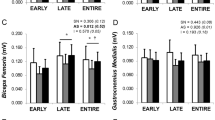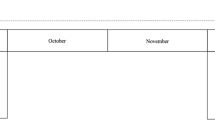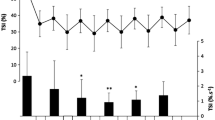Abstract
This study aimed to determine changes in spring-mass model (SMM) characteristics, plantar pressures, and muscle activity induced by the repetition of sprints in soccer-specific conditions; i.e., on natural grass with soccer shoes. Thirteen soccer players performed 6 × 20 m sprints interspersed with 20 s of passive recovery. Plantar pressure distribution was recorded via an insole pressure recorder device divided into nine areas for analysis. Stride temporal parameters allowed to estimate SMM characteristics. Surface electromyographic activity was monitored for vastus lateralis, rectus femoris, and biceps femoris muscles. Sprint time, contact time, and total stride duration lengthened from the first to the last repetition (+6.7, +12.9, and +9.3%; all P < 0.05), while flight time, swing time, and stride length remained constant. Stride frequency decrease across repetitions approached significance (−6.8%; P = 0.07). No main effect of the sprint number or any significant interaction between sprint number and foot region was found for maximal force, mean force, peak pressure and mean pressure (all P > 0.05). Center of mass vertical displacement increased (P < 0.01) with time, together with unchanged (both P > 0.05) peak vertical force and leg compression. Vertical stiffness decreased (−15.9%; P < 0.05) across trials, whereas leg stiffness changes were not significant (−5.9%; P > 0.05). Changes in root mean square activity of the three tested muscles over sprint repetitions were not significant. Although repeated sprinting on natural grass with players wearing soccer boots impairs their leg-spring behavior (vertical stiffness), there is no substantial concomitant alterations in muscle activation levels or plantar pressure patterns.




Similar content being viewed by others
References
Arampatzis A, Brüggeman G-P, Metzler V (1999) The effect of speed on leg stiffness and joint kinetics in human running. J Biomech 32(12):1349–1353
Bishop D, Girard O (2010) Repeated-sprint ability. In: Cardinale M, Newton R, Nosaka K (eds) Strength and conditioning biological principles and practical applications. Wiley, New York, pp 223–241
Buchheit M, Bishop D, Haydar B, Nakamura FY, Ahmaidi S (2010) Physiological responses to shuttle repeated-sprint running. Int J Sports Med 31(6):402–409
Chelly SM, Denis C (2001) Leg power and hopping stiffness: relationship with sprint running performance. Med Sci Sports Exerc 33(2):326–333
Eils E, Streyl M, Linnenbecker S, Thorwesten L, Volker K, Rosenbaum D (2004) Characteristic plantar pressure distribution patterns during soccer-specific movements. Am J Sports Med 32(1):140–145
Farley CT, Gonzalez O (1996) Leg stiffness and stride frequency in human running. J Biomech 29(2):181–186
Farley CT, Houdijk HH, Van Strien C, Louie M (1998) Mechanism of leg stiffness adjustment for hopping on surfaces of different stiffnesses. J Appl Physiol 85(3):1044–1055
Finni T, Kyrolainen H, Avela J, Komi PV (2003) Maximal but not submaximal performance is reduced by constant-speed 10-km run. J Sports Med Phys Fitness 43(4):411–417
Ford KR, Manson NA, Evans BJ, Myer GD, Gwin RC, Heidt RS Jr, Hewett TE (2006) Comparison of in-shoe foot loading patterns on natural grass and synthetic turf. J Sci Med Sport 9(6):433–440
Fourchet F, Kuitunen S, Girard O, Millet GP (2007) Comparison of foot plantar distribution between training and spike shoes in young sprinters. Sci Sports 22:176–178
Girard O, Eicher F, Fourchet F, Micallef JP, Millet GP (2007) Effects of the playing surface on plantar pressures and potential injuries in tennis. Br J Sports Med 41(11):733–738
Girard O, Micallef J-P, Millet GP (2010a) Changes in spring-mass model characteristics during repeated-running sprints. Eur J Appl Physiol 111(1):125–134
Girard O, Millet GP, Slawinski J, Racinais S, Micallef J-P (2010b) Changes in leg-spring behavior during a 5000 m self-paced run in differently trained athletes. Sci Sports 25(2):99–102
Hay JG (1994) The biomechanics of sports techniques, 4th edn. Prentice Hall International, London, pp 396–423
Hobara H, Inoue K, Gomi K, Sakamoto M, Muraoka T, Iso S, Kanosue K (2010a) Continuous change in spring-mass characteristics during a 400 m sprint. J Sci Med Sport 13(2):256–261
Hobara H, Inoue K, Muraoka T, Omuro K, Sakamoto M, Kanosue K (2010b) Leg stiffness adjustment for a range of hopping frequencies in humans. J Biomech 43(3):506–511
Kelly LA, Racinais S, Tanner CM, Grantham J, Chalabi H (2010) Augmented low dye taping changes muscle activation patterns and plantar pressure during treadmill running. J Orthop Sports Phys Ther 40(10):648–655
Kernozek TW, Zimmer KA (2000) Reliability and running speed effects of in-shoe loading measurements during slow treadmill running. Foot Ankle Int 21(9):749–752
Lieberman DE, Venkadesan M, Werbel WA, Daoud AI, D’Andrea S, Davis IS, Mang’eni RO, Pitsiladis Y (2010) Foot strike patterns and collision forces in habitually barefoot versus shod runners. Nature 463(7280):531–535
McMahon TA, Cheng GC (1990) The mechanics of running: How does stiffness couple with speed? J Biomech 23(Suppl 1):65–78
Mendez-Villanueva A, Hamer P, Bishop D (2008) Fatigue in repeated-sprint exercise is related to muscle power factors and reduced neuromuscular activity. Eur J Appl Physiol 103:411–419
Mero A, Komi PV, Gregor RJ (1992) Biomechanics of sprint running. A review. Sports Med 13(6):376–392
Morin JB, Dalleau G, Kyrolainen H, Jeannin T, Belli A (2005) A simple method for measuring stiffness during running. J Appl Biomech 21(2):167–180
Morin JB, Jeannin T, Chevallier B, Belli A (2006) Spring-mass model characteristics during sprint running: correlation with performance and fatigue-induced changes. Int J Sports Med 27(2):158–165
Morin JB, Samozino P, Zameziati K, Belli A (2007) Effects of altered stride frequency and contact time on leg-spring behavior in human running. J Biomech 40(15):3341–3348
Müller R, Grimmer S, Blickhan R (2010) Running on uneven ground: Leg adjustments by muscle pre-activation control. Hum Mov Sci 29(2):299–310
Nummela AT, Heath KA, Paavolainen LM, Lambert MI, St Clair Gibson A, Rusko HK, Noakes TD (2008) Fatigue during a 5-km running time trial. Int J Sports Med 29(9):738–745
Paavolainen L, Nummela A, Rusko H, Hakkinen K (1999) Neuromuscular characteristics and fatigue during 10 km running. Int J Sports Med 20(8):516–521
Perrey S, Racinais S, Saimouaa K, Girard O (2010) Neural and muscular adjustments following repeated running sprints. Eur J Appl Physiol 109(6):1027–1036
Queen RM, Charnock BL, Garrett WE Jr, Hardaker WM, Sims EL, Moorman CT 3rd (2008) A comparison of cleat types during two football-specific tasks on fieldturf. Br J Sports Med 42(4):278–284
Racinais S, Bishop D, Denis R, Lattier G, Mendez-Villaneuva A, Perrey S (2007) Muscle deoxygenation and neural drive to the muscle during repeated sprint cycling. Med Sci Sports Exerc 39(2):268–274
Rozema A, Ulbrecht JS, Pammer SE, Cavanagh PR (1996) In-shoe plantar pressures during activities of daily living: implications for therapeutic footwear design. Foot Ankle Int 17(6):352–359
Sims EL, Hardaker WM, Queen RM (2008) Gender differences in plantar loading during three soccer-specific tasks. Br J Sports Med 42(4):272–277
Stolen T, Chamari K, Castagna C, Wisloff U (2005) Physiology of soccer: an update. Sports Med 35(6):501–536
Tessutti V, Trombini-Souza F, Ribeiro AP, Nunes AL, Sacco Ide C (2010) In-shoe plantar pressure distribution during running on natural grass and asphalt in recreational runners. J Sci Med Sport 13(1):151–155
Weist R, Eils E, Rosenbaum D (2004) The influence of muscle fatigue on electromyogram and plantar pressure patterns as an explanation for the incidence of metatarsal stress fractures. Am J Sports Med 32(8):1893–1898
Willson JD, Kernozek TW (1999) Plantar loading and cadence alterations with fatigue. Med Sci Sports Exerc 31(12):1828–1833
Winter DA (1990) Biomechanics and motor control of human movement, 2nd edn. Wiley Inter Science, New York, pp 75–102
Wong PL, Chamari K, Chaouachi A, Mao de W, Wisloff U, Hong Y (2007) Difference in plantar pressure between the preferred and non-preferred feet in four soccer-related movements. Br J Sports Med 41(2):84–92
Acknowledgments
We thank Aziz Mohammed Farooq for assistance with statistical analyses and Fuad Almudheki for assistance in data collection.
Author information
Authors and Affiliations
Corresponding author
Additional information
Communicated by Jean-René Lacour.
Rights and permissions
About this article
Cite this article
Girard, O., Racinais, S., Kelly, L. et al. Repeated sprinting on natural grass impairs vertical stiffness but does not alter plantar loading in soccer players. Eur J Appl Physiol 111, 2547–2555 (2011). https://doi.org/10.1007/s00421-011-1884-5
Received:
Accepted:
Published:
Issue Date:
DOI: https://doi.org/10.1007/s00421-011-1884-5




